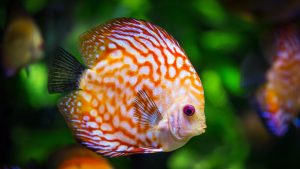Alectis alexandrina
Alectis alexandrina The African threadfish (Alectis alexandrina Geoffroy Saint-Hilaire, 1817) is a fish belonging to the Carangidae family. Systematic –
Read more
 Fish are a diverse group of basically aquatic vertebrate organisms, covered in scales and equipped with fins, which breathe through their gills.
Fish are a diverse group of basically aquatic vertebrate organisms, covered in scales and equipped with fins, which breathe through their gills.
This large group, belonging to the Pisces superclass, contains over 32,000 known species which, in turn, cover almost 50% of the total species of the subphylum vertebrata.
The fish swim thanks to the fins, which are formed by folds of the skin supported by small sticks, called rays.
The fish use their fins as oars to push themselves into the water.
Interesting is what concerns the body temperature of the fish; this is the same as the water in which they live; if the water temperature changes, so does that of the body. Animals that have a temperature similar to that of the surrounding environment are called cold-blooded animals or ectotherms.
Generally, fish have a tapered body, which allows them to move quickly in the water.
Almost all fish have the body covered with small, almost transparent sheets, called scales, which have a protective function. The flakes are arranged one on top of the other, like the tiles on a roof; they are formed of a substance similar to that of nails, and grow as the fish grows.
Furthermore, the fish breathe through the gills, small fringed red plates, located on the sides of the head. The red color of the gills is due to the presence of numerous blood vessels. The fish opens its mouth to swallow water, then pushes it towards the gills, which are responsible for extracting the oxygen. Oxygen passes to the blood and blood vessels carry it throughout the body. At the same time, again through the gills, the fish expels carbon dioxide.
From the food point of view, most of the fish are carnivorous; the preys are invertebrate animals, small or large, and insect larvae. There are also herbivorous fish, which feed on algae and other vegetables. Some are filter feeders, like the whale shark, and swallow microscopic plants and animals that float in the water.
As for reproduction, most fish use external fertilization: the eggs, that is, are fertilized outside the mother’s body. The males get close to the females; when these release the eggs in the water, the males emit the spermatozoa on them and fertilize them. Most fish expel a very large number of eggs into the water.
Fish represent, in the trophic chain, a fundamental link and a very important source of food for man. Over 20% of the animal protein consumed in the world comes from fish.
Guido Bissanti
Alectis alexandrina The African threadfish (Alectis alexandrina Geoffroy Saint-Hilaire, 1817) is a fish belonging to the Carangidae family. Systematic –
Read moreLepidotrigla dieuzeidei The spiny gurnard or smooth gurnard or spiny gurnard (Lepidotrigla dieuzeidei) is a small fish belonging to the
Read moreChelidonichthys obscurus The longfin gurnard or long-finned gurnard, shining gurnard (Chelidonichthys obscurus Bloch & Schneider 1801) is a sea fish
Read moreChelidonichthys cuculus The red gurnard (Chelidonichthys cuculus) is a sea fish belonging to the Triglidae family. Systematic – From a
Read moreEutrigla gurnardus The grey gurnard (Eutrigla gurnardus Linnaeus, 1758) is a fish belonging to the Triglidae family. Systematic – From
Read moreChelidonichthys lastoviza The streaked gurnard or African gurnard, rock gurnard (Chelidonichthys lastoviza Bonnaterre, 1788) is a sea fish belonging to
Read moreEcological role of cetaceans Cetaceans (Cetacea Brisson, 1762) are an infraorder of eutherian mammals, completely adapted to aquatic life. Cetaceans
Read moreEcological role of fish Fish are a heterogeneous group of basically aquatic vertebrate organisms, covered with scales and equipped with
Read moreChelidonichthys lucerna The gurnard or sapphirine gurnard, tube-fish, tubfish, yellow gurnard (Chelidonichthys lucerna Linnaeus, 1758) is a fish belonging to
Read moreTrigla lyra The piper gurnard or piper, lyre gurnard (Trigla lyra Linnaeus, 1758) is a sea fish belonging to the
Read more